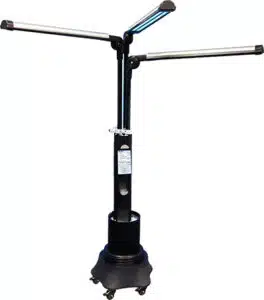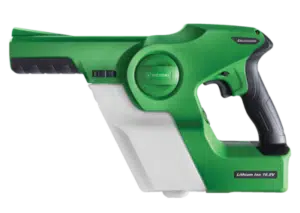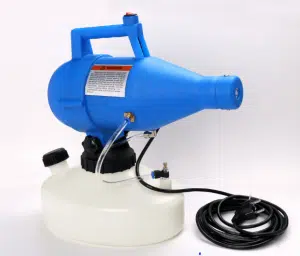Reviewing and improving your cleaning practices and standards isn’t optional if you want to appeal to guests in a post-COVID-19 world. In our last article, we zoomed in on the distinction between cleaning, sanitisation and disinfecting. They are not the same thing, even though the words seem to get used interchangeably. Let’s take a second to recap on what each means.
- Cleaning a surface removes visible debris, dirt and dust
- Sanitising a surface makes that surface free of visible dirt contaminants which could affect your health. It is meant to reduce the occurrence of bacteria, viruses and fungi
- Disinfecting a surface kills microscopic organisms.
So there’s an extra step in the cleaning process that all hoteliers should be considering, and that’s disinfecting the room.
In part 1, we also looked at some of the tech that can help you reach the levels of disinfection needed. So how do you narrow down which method you should invest in?
Things to consider when choosing a solution
Getting cleanliness right in the ‘new normal’ can seem overwhelming. We’ve given a detailed breakdown of the things you need to think about in a previous article, but here they are in a nutshell:
- Common areas and high touch areas will need cleaning more often
- You should consider disinfecting all hard and soft surfaces like carpets and decorative pillows in guest rooms after each stay / check-out
- Visible solutions can inspire guest confidence – e.g. being seen disinfecting surfaces with professional equipment will win guests trust & confidence
- Whatever technology you choose needs to be safe for staff and be easy to train them to use
- Time is of the essence – you’ll need to consider the length of time some chemicals are left on a surface, the coverage they provide and how long areas should be vacant after application
- Labour cost – some technologies require staff to undertake specialist training. The amount of setup time and labour involved in disinfecting the room also needs to be taken into consideration.
The solutions on the table – and the verdict
Luckily there are a range of solutions to the cleaning conundrum, including UV-C which uses UV light to sanitise, fogging chemical sprays with a fogging machine, and electrostatic spraying via a special cordless handheld gun or backpack.
We’ve ranked each one against the factors outlined above to see which ticks the most boxes.
| Criteria | UV-C | Electrostatic Spraying | Fogging |
|---|---|---|---|
| Easy to use for regular cleaning in a hotel environment | UV-C requires staff to be trained and there are many safety measures that need to be considered. The unit is powered and needs to be setup in a room. It generally needs to be moved 2 to 3 times to disinfect the entire room | The electrostatic sprayers are handheld and cordless. Minimal training is required | Often powered with a cord so less flexible for use in a hotel room or public area. Slow application required to get the surface wet long enough for the disinfectant to be effective. Longer process as needs wiping down afterwards |
| Works on soft surfaces | To an extent, but hidden areas of the surface may not be disinfected | Yes | Yes |
| Visible equipment | Yes | Yes | Yes |
| Staff Safety | Training needed – can damage retinas if used incorrectly. But no chemicals used | Simple to use. Basic PPE requirements are eye protection and mask (depends on chemical) | Staff need training and full PPE equipment due to miniscule size of microns |
| Guest Saftey | Possibility of patchy disinfection due to “shadowing”, that is not working on hidden surfaces. Cannot be used in occupied rooms but rooms can be occupied shortly after as no chemical residue left | Can be used in occupied areas such as the lobby and public areas. Quick drying time less than 10 mins (even less for most chemicals) means a guest room can be occupied very quickly | Guests need to be kept away from treated areas for at least an hour after treatment. High chemical use compared to traditional methods and electrostatic spraying. Has been known to set off the smoke detector within guest room |
| Cost Effectiveness | Large capital cost for the equipment. Lower ongoing cost as no chemicals are involved just labour and replacement lamps | Moderate equipment cost. Electrostatic sprayers are 70% quicker and use 65% less chemical than traditional “spray and wipe” methods | Lowest equipment cost. Takes more time and uses more chemical than electrostatic spraying and must be wiped down |
| Labour Cost | Highest labour cost. Staff training is required. Equipment needs to be setup and moved 2 to 3 times within the one room to be effective | Lowest labour cost. Staff training is minimal. Cordless device allows for quick movement between rooms. A standard guest room can be disinfected in less than 5 minutes | Moderate labour cost. The fogger needs to be powered. Slower application process and surfaces must be wiped down afterwards |
| Image |  |  |  |
Our verdict
We’d say electrostatic spraying, as used by the Marriot and Hilton, seems to offer the safest and most effective solution. It also has lower associated costs, is quicker and less chemical used.
To recap on the fundamentals of electrostatic sprayers: they are based on the principle that opposite charges attract and like charges repel. The electrostatic sprayer places a positive charge on the liquid before entering the nozzle. This means that no matter which angle you disinfect a surface from, the charge created by the electrostatic sprayer makes the disinfectant wrap around and cling to the entire surface, giving 360-degree coverage. Rather than wiping off the disinfectant, it is left to dry on the surface, meaning it stays there longer and kills more of its target microbes. No wiping also means no cross-contamination.
The bottom line
Ultimately it is up to each individual business to look at their resources and what suits them best in terms of post Covid-19 disinfectant procedures. It’s important to do your due diligence and be aware of the options and to evaluate what is the most appropriate for your business in terms of effectiveness and cost, including equipment, labour costs and the modifications to procedures and chemicals.
Each of the technologies involves some initial equipment cost, but in the long run they will help save you time, money, and will boost customer confidence & loyalty.

